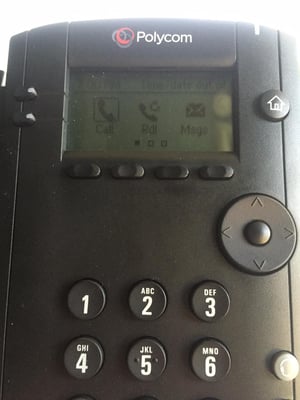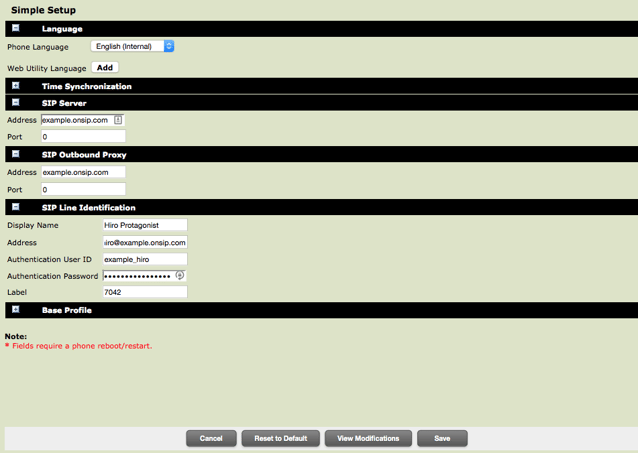Summary
| Overall: |      |
| Configuration: |      |
| OnSIP Testing: |      |
| Voice Quality: |      |
| Ease of Use: |      |
Quick Specs
- 1 SIP account
- Basic LCD screen
- 1/100 Ethernet port
- 12-key dialpad, home, speaker, mute, headset, and volume buttons. The menu is operated by a 4-way navigation cluster
Pros
- Excellent voice quality
- Sleek and sturdy frame
- Solid minimalist design
Cons
- Price
- Only one SIP account
Note: The Polycom VVX 101 was discontinued in 2020. Support continues through 2025.
The Polycom VVX 101 is the entry-level phone in the Polycom Soundpoint IP’s successor line. The previous VVX line was a wonderful leap forward in design and functionality that utilized recent software innovations to inspire hardware designs. Polycom also engaged in forward thinking with the release of its UC 4.0 software.
The VVX 101 comes with one line and a basic LCD screen (one to two character rows plus icon row). It supports the G.722 audio codec up to 7 kHz on all audio paths (speaker, handset, headset). The phone comes with a 1/100 Ethernet port, a 12-key dial pad, home, speaker, mute, headset, and volume buttons. The menu is operated by a four-way navigation cluster with center “select” key, and the speakerphone broadcasts as an IEEE 1329 full duplex.
The VVX 101 markets itself as a basic desk phone with solid operability and Polycom standards. But does the phone live up to its image? We took the VVX 101 for a spin to find out.
First Impressions
The immediate first impression with the VVX 101 is how much smaller it is than other phones in the VVX line. It’s closer in size to the Soundpoint IP 335. The LCD screen is smaller, but the font is larger. While this makes it easier to read, it also means the screen conveys less information. The LCD has more in common with the SPIP line, although the backlit screen presents text in a clear and complete way. Thankfully, most configuration can be done through the web portal. While you can configure the phone through the face buttons, we wouldn’t recommend it.
The face buttons all use the same iconography of other Polycom phones. The commonality amongst the line is a plus and makes the phone easier to use. The compact size of the VVX 101 does remove some functionality. Gone are the keys dedicated to Transfer, Voicemail, and Do Not Disturb. This functionality is all relegated to the small LCD screen. If you use the phone for much more than placing or receiving a single call, you may quickly grow frustrated with this device.
The three function face buttons kept on the device are the Headset, Speakerphone, and Mute buttons. This choice says to us that the buttons were chosen due to a physical design decision rather than to optimize functionality. If this phone is intended for a common area or call center setup, why implement the speaker button over something like a transfer button?
The outer shell of the VVX is made from the same material as the most expensive phones in the VVX line. This gives the phone a sturdy feeling that other entry-level phones such as the Cortelco C56 lack. There was not much of a difference between this phone and the Polycom VVX 400, which has been our primary phone for the past few years. The sound quality on the VVX 101 is superb. While we couldn’t break down the phone, looking through the data sheets, we suspect the speakerphone and handset are on the same line. This means that you’ll get as good a sound from the entry-level phones as you’ll get with the executive-level VVX 600. If there is a difference in sound, it was negligible to our ears.
Features

The VVX 101 is one of the barest of the bare bones phones we've reviewed in prior months. With just one line, the phone is designed for a single SIP account, meaning that those who hope to switch between aliases will have to look elsewhere. This model is clearly meant for simple phone usage that does not ferry traffic between SIP accounts. Basic voice calling is what you should expect to get out of the VVX 101.
The only buttoned features on the face of the VVX 101 include Handset, Speakerphone, and Mute. The home button brings users to a short features menu. The menu offers a redial function, a contact directory, recent calls, call forward, and do not disturb. The Preferences subsection allows users to modify the language, time and date, auto answer, claim presence, and implement call waiting.
Other subsections allow users to modify the platform, network, lines, diagnostics, licenses, and phone location. Overall, the functionality is stripped down to the basic building blocks of a phone calling experience. Unlike other entry-level phones such as the Cortelco C56, the VVX 101 does not come with busy lamp field. It also does not have an LED backlight for its screen. But there is a something of an art to the VVX 101's minimalism. Without a single extraneous feature, the 101 is a tribute to the craft of subtraction.
Voice Quality
Sound quality is one of the leading features that separates Polycom devices from other desk phones. And while the VVX 101 may be intentionally sparse on features, it still delivers the world-class sound quality that other Polycoms are known for. This explains why the price tag is hovering about twenty dollars higher than other comparable models.
The sound quality is, quite simply, superb. SIP to SIP calling over G.722 sounds fabulous. In the past, HD calls over speakerphone have confused coworkers into thinking that remote workers were actually visiting the office. While that hasn’t happened in our testing of the VVX 101 units, it is using the same speaker model. Polycom phones have long been the standard in how SIP phones should sound.
Compatibility Testing
At OnSIP, we put each of the phones we use through a multi-step interoperability test in which we apply ~30 test cases. An example of a test case would be the following:
Test phone calls phone B
B picks up
B puts test phone on hold
B calls phone C
C picks up
B transfers test phone to C
Call must be transferred correctly to C. B must be released correctly after the transfer. When C picks up, audio must work in both ways between test phone and C. When test phone is on hold, there is no audio between it and phone B.
We did not experience any issues during our tests with the Polycom VVX 101.
Phone Configuration
Step 1: Gather information for each user.
Each user has a set of credentials that will be needed to configure each phone. For each phone that you are configuring, obtain the following credentials. You can find this information in the user detail pages under the Users tab in the Phone Configuration section.

Step 2: Log into your Polycom phone through a web browser.
When your phone is powered on and connected to your LAN, use a browser to navigate to the IP address of your phone.
Step 3. Enter your user information from Step 1.
For most setups, you will need to configure "Simple Setup." If you are trying to configure multiple users or multiple line appearances, you can repeat the steps below for each of the identities you are configuring. You can insert boot.onsip.com as the provisioning server to save time on provisioning:
- Server Address: Domain
- Authentication User: Auth Username
- Authentication Password: SIP Password
- SIP Address: Username
- Display Name: Whatever You Like
- Proxy Server Address: sip.onsip.com
- Enable Registration: Checked

Step 4. Confirm that your phone is registered.
In the Admin Portal, click on the "Users" tab. You will see a green "online" notation next to each user with a registered phone.
Final Thoughts
Of all the bare bones phones we've reviewed in the past several months, the Polycom VVX 101 feels the least entry level of them all. This is somewhat counterintuitive, since the VVX 101 offers perhaps the least number of features we've seen in the past several reviews. But the phone’s excellent sound quality and the physical sturdiness of the frame give off an unmistakable vibe of superior craftsmanship. Yes, from the moment you pick up the VVX 101's receiver, you'll know that you are in the hands of a Polycom device.
Despite the phone's limitations, including just a single SIP line, the VVX 101 nails the less-is-more aesthetic in the classiest way possible. That's why the exclusion of so many of the features we've become used to in the average SIP phone makes sense in light of the VVX 101's design ethos. The 101 does minimalism the right way, without sacrificing the overall quality of the device.
When it comes to entry-level phones, the Polycom VVX 101 is at the top of its class. The biggest drawback is basically the price. It's more than $20 more than the Cortelco C56 and about $30 higher than Grandstream's entry-level phone. But you get what you pay for. The excellence of the device is apparent, and when implemented for modest phone usage, the Polycom VVX 101 is hard to beat.

